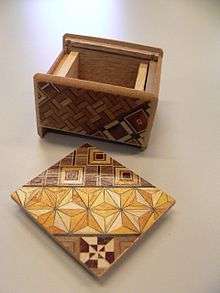Puzzle box


A puzzle box (also called a secret box or trick box) is a box that can only be opened through non-obvious means. Some puzzle boxes may require only a simple move while others have the solver progressing through a series of sequential discoveries.
Modern puzzle boxes developed from furniture and jewelry boxes with secret compartments and hidden openings, known since renaissance time. Puzzle boxes produced for entertainment first appeared in Victorian England in the 19th Century (Hoffmann 1893; Sanders and Sanders 1997) and as tourist souvenirs in the Interlaken region in Switzerland (Arenski et al. 2005 provide details of the Swiss carving tradition but do not cover trick boxes) and in the Hakone region of Japan at the end of the 19th and the beginning of the 20th Century (Iwasaki 2003). Boxes with secret openings appeared as souvenirs at other tourist destinations during early 20th Century, e.g. Amalfi Coast, Madeira, Sri Lanka (Hajek 2008, 2012) though these were mostly 'one-trick' traditions. Chinese cricket boxes represent a remarkable example of intricate boxes with secret openings (Hajek 2011, deVreugd 2013).
Interest in puzzle boxes subsided during and after the two World Wars. The art was revived in 1980's by three pioneers of this genre: Akio Kamei in Japan (Yoshihagara 1995), Trevor Wood in England, and Frank Chambers in Ireland (Hajek 2008). There are currently a number of artists producing puzzle boxes, including the Karakuri group in Japan set up by Akio Kamei (Karakuri Creation Group 2008), US puzzle box specialists Robert Yarger (Dawson 2012) and Kagen Sound and a number of other designers and puzzle makers who produce puzzle boxes across countries and continents.
See also
References
- Arenski J, Daniels S, Daniels M (2005) Swiss Carvings 1820-1940. Antique Collectors Club, Woodbridge
- Hajek, P. (2008) Frank Chambers: Obituary. IPP27, 123.
- Hajek, P. (2008) Madeira puzzle boxes. CFF, 75, 3-6
- Hajek P (2011) Chinese cricket boxes with secret opening. CFF, 85, 31-34
- Hajek, P. (2012) Sri Lanka carvings with secret compartments. CFF, 89, 21-23
- Hoffmann P. (1893) Puzzles Old and New. Warne, London
- Iwasaki S. (2003) Karakuri works in Hakone & Odawara. Karakuri Creation Group, Odawara
- Sanders W., Sanders C. Pocket Matchsafes. Reflections of Life & Art, 1840-1920. Schiffer, Atglen, USA
- Yoshigahara N. (1995) Karakuri. Akio Kamei Art Works. Japanese publisher
- Karakuri Creation Group (2008) Evolving Karakuri Box, Odawara 2008 (in Japanese)
- Yarger R., Dawson M. (2012) Stickman Milestone Puzzle Book, Yarger